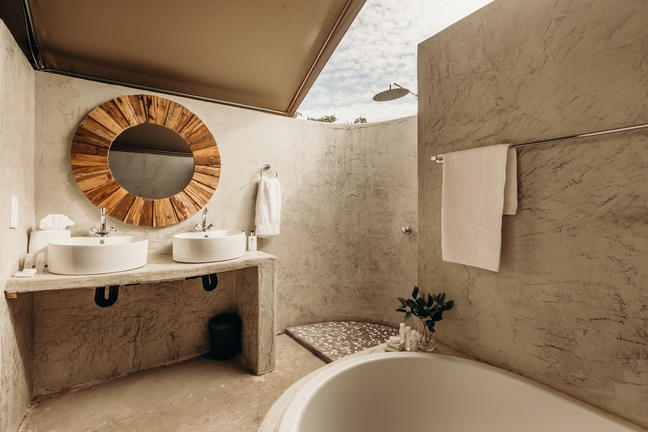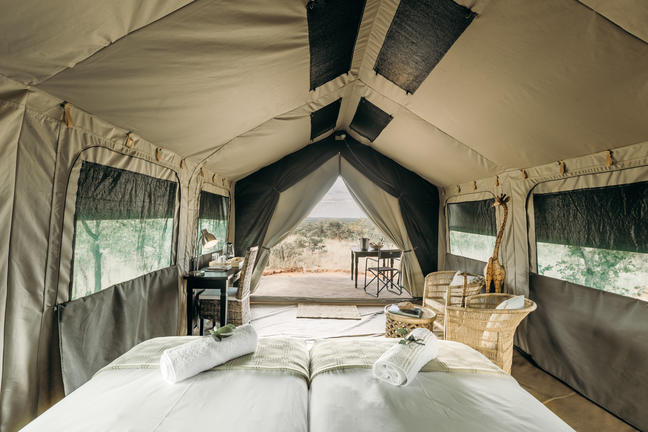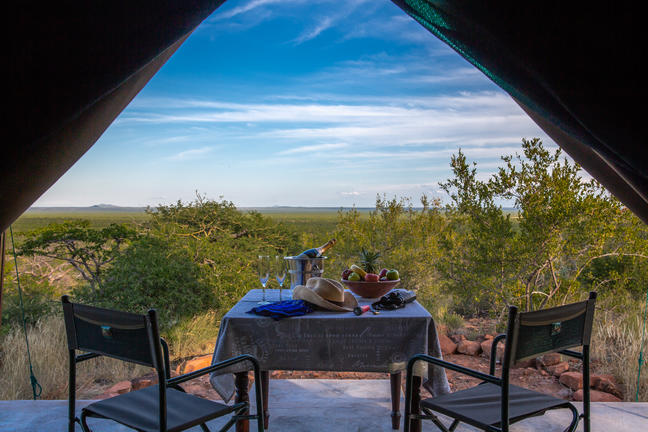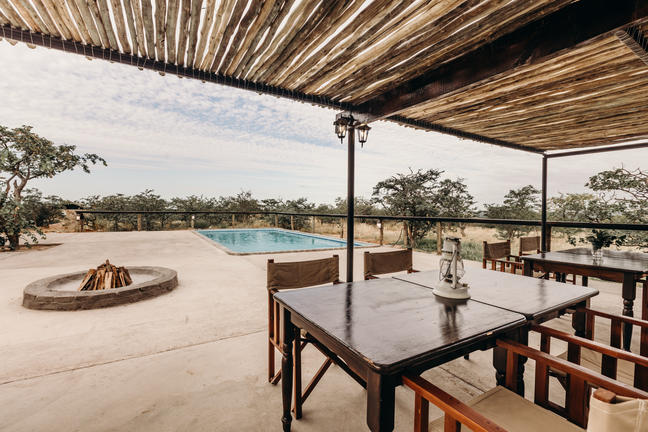- Info
- Images
- Video
- Rooms
- Facilities
- Activities and Services
MAPESU WILDERNESS CAMP offers 10 Serengeti luxury tents, nestled on a hillside with stunning 180º views of the vast mopane wilderness. Each features an en-suite bathroom, outdoor shower, AC/heating, and luxurious bedding.
The restaurant and bar offers delicious local and international dishes. The large, comfortable and inviting spaces will help usher in unforgettable moments. Relax by the pool with a drink or on your private deck while listening to the sounds of Africa, enjoying breathtaking sunrises and sunsets.
Conference/Wedding facilities accommodate up to 120 people with accommodations for 58 guests at both accommodations at the reserve.
Mapesu Private Game Reserve offers immersive experiences focused on conservation and cultural encounters while offering two accommodation types from glamping at Mapesu Wilderness Camp to a luxury traditional safari lodge at Mopane Bush Lodge. Lastly,
350 meter from the Wilderness Camp is the campsite for those who wish to travel and stay on their terms with rental tents available on request and bookings directly with us.







Wilderness Tents
Nestled discreetly on a hillside, each of the 10 Serengeti tent are thoughtfully designed with an en-suite bathroom, complete with a bathtub and outdoor shower, air conditioning, 2 twin beds/ 1 double bed, coffee/tea station, large closet, table, and two chairs inside and out on the patio for their 180º private views. Onsite pool, restaurant and bar. large communal spaces with free wifi.







Property Facilities
Bar, Barbeque Facilities, Communal Dining, Conference Centre, Internet Access (Complimentary), Mobile Connectivity, Pool, Restaurant, Secure Parking, Spa, Vegetarian
Room Facilities
Air Conditioning, Complimentary Wi-Fi, Dressing Gowns, Electrical Outlets, Internet Access (Complimentary), Laundry Service (Available), Outside Shower, Safe, Shower, Tea / Coffee
Available Services
Airport Shuttle (Available), Credit Card Facilities, Laundry Service (Available)
Activities on Site
Bird Watching, Fine Dining, Game Drives, Game Viewing Hide, Game Viewing, Game Walks, Massages, Natural History Tours, Night Drives, Safaris, Walks (Guided), Wildlife Tours
Activities Nearby
Animal Encounters, Big 5, Bird Watching, Catch-and-release Fishing, Cultural Tours, Game Drives, Game Viewing, Game Walks, General Sightseeing, Historical Tours, Museums, Safaris, Walks (Guided), Wildlife Tours, Wine Tasting
Our beautiful home is a unique 7200 ha game reserve. Our guides would love to show you around, as there is so much to discover, sense, and experience! Mapesu is home to elephants, leopards, cheetahs, African wild dogs, buffalo, hippopotami, and a wide variety of big and small antelope. Come enjoy a Game Drive in the comfort of a game viewer and discover Mapesu’s beauty.


.jpg)


.png)
.png)



.jpg)
The night brings the animals to life! Being enveloped in the electric sounds and secretive life of the animals under the canvas of stars in the comfort of our game viewer is exciting. The evening brings opportunities to see species you are unlikely to find during the day. Be on the lookout for bush babies (galagos), bushpigs, hyenas, genets, and the tiniest chameleons. Maybe you will get lucky and experience a thrilling encounter with a leopard!
.jpg)




Get an introduction to the ‘behind-the-scenes’ conservation operations that make Mapesu Private
Game Reserve tick. Learn about conservation management, the daily duties ranging from bush
clearing, erosion control, and anti-poaching to stocking control and fence maintenance. Set up a
camera trap with your guide and discover what came past! Whilst enjoying being out in the bush, you will leave this unique experience with a better understanding of the conservation of our beautiful
flora and fauna.




This exciting activity is to locate the animals through the use of telemetry, technology, and old-fashioned tracking. It will include both mobile and on-foot tracking while accompanied by an experienced guide. The experience will give you a deeper understanding of what it takes to safeguard, protect, and conserve the endangered species here at Mapesu. Wild dog or cheetah.



.jpg)


Put on your walking shoes to embark on a guided tour through the African bush for an all-encompassing experience. Immerse yourself in the tranquility of being in direct contact with nature. Traversing on foot without the confines of a vehicle allows for a greater sense of exploration. You will gain environmental awareness through listening, observing, and interpreting first everything around you. Accompanied by our expert guides, this will be a truly unique and unforgettable journey. Walk in the footsteps of majestic creatures like the African Elephant, tracing their ancient paths alongside us.

.jpg)




The rock art shelter is known worldwide as one of the most impressive collections of San rock art and one of the top 10 in South Africa. This tour will leave you amazed and in awe of the ancient, unique, and stunning paintings encrypted on sandstone thousands of years ago. Our guide will help you understand and learn about the San people, their belief system surrounding these rare and unique works of art, their culture, and their ways of life.




Grab your binoculars and join us for a guided tour to see some of the most remarkable bird life Limpopo has to offer! This tour is completely tailored to your wishes. Depending on what you would like to see, we have various locations and different habitats to look for that one feathered friend you would like to target. Our birding excursions are possible at the following locations; Mapungubwe National Park (both the Western and Eastern sections), Mapesu Private Game Reserve, Scroda Dam, and San Maria Wetlands. Mapungubwe National Park has 383 recorded Bird species and over 433 in our region, including the elusive Pel’s fishing owl and the visiting broad-billed rollers.



.jpg)







Join us on a drive in the comfort of a game viewer in South Africa’s youngest and most northern national park. Covering roughly 28,000 ha the park plays an essential role in conserving the stunning and unique Limpopo Valley’s ecology.




.png)
.png)
You will join us in the western section of Mapungubwe National park for this game drive. Here we have the opportunity to spend some quality time at Maloutswa hide overlooking the waterhole and the animal activities surrounding it. The hide offers a great way to experience wildlife - big and small without interrupting their daily activities and natural behaviour.
.jpg)







Walk the steps to the summit of the UNESCO World Heritage Site of Mapungubwe Hill, the location of
the first South African Bantu Kingdom. Guides will regale you with tales of gold artefacts and ancient
civilizations. After touring the Heritage site, you’ll visit the award-winning Mapungubwe Museum and view history and the treasures on display.




